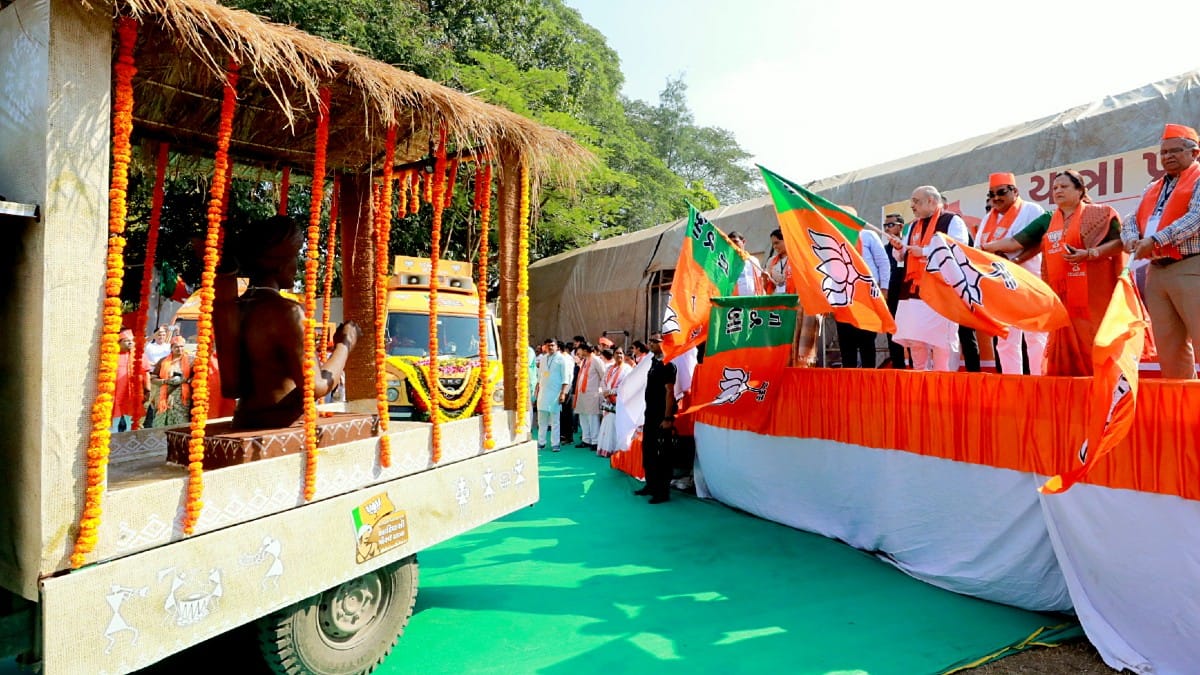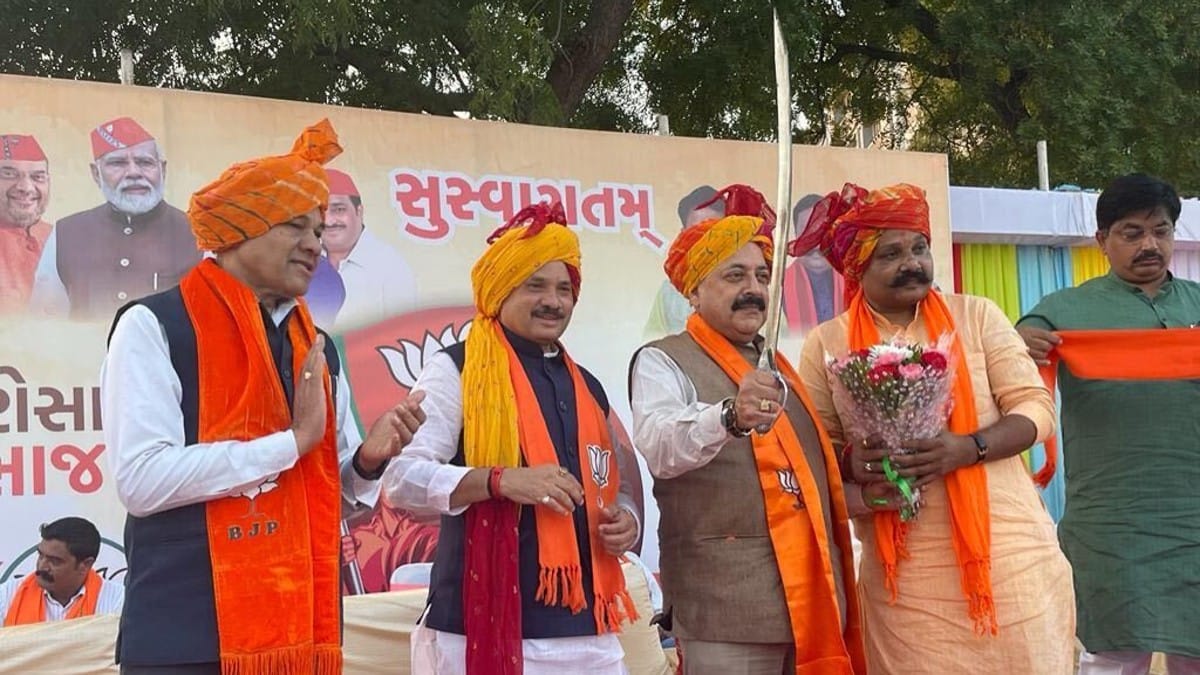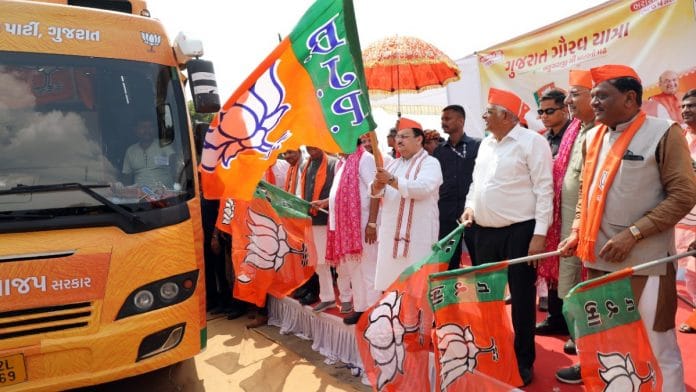Kheda: Five routes, 245 blocks, 144 assembly constituencies spanning 5,700 km — the Bharatiya Janata Party’s (BJP) Gaurav Yatra in poll-bound Gujarat, which concluded Friday, was testament to how crucial Prime Minister Narendra Modi’s home state is for the party.
Propounding the idea that India is expanding its global footprint under the leadership of Modi, a bhumiputra (son of the soil), the BJP wrapped its narrative around a crisp message for the electorate — Bharosa ni BJP sarkar (‘trustworthy BJP government’).
The mention of “Gujarati asmita (pride)”, a recurring theme in the state where Modi’s party has been in power for 27 years, was hard to miss. Besides Modi’s governance model, the Narmada canal issue, the Statue of Unity, and the abrogation of Article 370 were other talking points that found prominent mention in the BJP’s pitch to voters during its yatra.
A special route for its Gaurav Yatra focussing on tribal-dominated areas exhibited how the BJP, along with other parties, is vying for the favour of the state’s 89 lakh tribal voters, who constitute 14.8 per cent of Gujarat’s population.
This time around, the BJP’s aim is to break the record of the late Madhavsinh Solanki, under whose leadership the Congress rode to power in Gujarat in 1985, winning 149 of 182 seats.
But Modi’s party is facing a spirited challenge from the Aam Aadmi Party (AAP), which is now one of only three parties in power in more than one state, the other two being the BJP and the Congress. Added to that is pent-up anti-incumbency of nearly three decades.
The BJP is banking on Modi’s popularity to widen its mandate from 2017, when its winning tally dipped to an all-time low of 99 seats in the backdrop of the agitation for Patidar reservation (2015-17). But there’s no agitation of such a scale now.
Modi’s party received 49 per cent of the total votes polled in the state in 2017, with the Congress emerging as the second-largest party with 77 seats and a 41 per cent vote share.

Gujarat BJP chief C.R. Paatil, who returned to Gandhinagar on 19 October after concluding the Dwarka to Porbandar leg of the yatra, said the party “reached more than 40 lakh people” during the exercise. “We are moving towards a good mandate as the people have tested BJP governance in the state and at the Centre under the PM’s leadership. The pride of Gujarat and the country have been sky-high,” he told ThePrint.
Asked if Arvind Kejriwal would be able to mount a credible challenge to the ruling BJP in the state, Paatil said AAP was “only making noise” and that it would “have no impact on the result” of the assembly election to be held later this year.
“There is a change in narrative as the BJP is in power both in the state and at the Centre. In 2002, soon after the riots, Narendrabhai attacked Sonia Gandhi’s foreign origin and Italian heritage. In 2007, he again attacked Sonia Gandhi for her ‘merchant of death’ remark and invoked Pakistan for polarisation,” said a state BJP leader who did not wish to be named.
This time around, however, “attacking Congress would not be beneficial for the BJP” and AAP “can be at the receiving end of veiled attacks,” he added.
“The narrative is centred around Modi because, in his home state, the dynamics are different. People are emotionally connected with Modi, unlike other states where they understand the difference between assembly and parliamentary elections,” the leader said.
Also Read: How Modi govt extending free grains scheme could help BJP in Gujarat, Himachal polls
Why this Gaurav Yatra was different
In contrast to the BJP’s four previous Gaurav Yatras (2002, 2007, 2012 and 2017), this one traversed five routes: Bechraji in Mehsana to Mata no Madh in Kutch district, Dwarka to Porbandar, Zanzarka in Ahmedabad to Gir in Gir Somnath district, Unai in Navsari (southern Gujarat) to Fagvel in Kheda (central Gujarat) and from Una to Ambaji (northern Gujarat).
In 2017, the yatra covered two routes while the 2002 yatra — when Modi took over the reins of the Gujarat BJP from Keshubhai Patel — spanned a single route.
“We covered 15 public meetings a day. We have done 150 such meetings and over 50 central and state ministers participated. The most significant part was the special route going through tribal-dominated assembly segments where the party’s performance was weak in the 2017 polls,” said Gujarat BJP vice president Gordhanbhai Zadafia.

Also, between 2002 and 2012, Modi – then chief minister — was the face of the Gujarat BJP and travelled across the state as part of the Gaurav Yatras.
But this time around, the chief minister — Bhupendra Patel — joined it only at a few places. Moreover, there was hardly any mention of Patel or his predecessors Vijay Rupani or Anandiben Patel — now governor of Uttar Pradesh — throughout the yatra.

“Nobody will vote for the chief minister (Patel) and his work despite his humble background. Moditva has replaced Hindutva in Gujarat. We want people to realise the scale of development and creation of jobs which Gujarat saw because of Modi despite Covid,” a senior state BJP leader told ThePrint on condition of anonymity.
He added that the “Vedanta-Foxconn semiconductor plant will create thousands of jobs,” and the “Rs 22,000 crore development projects in Dahod are happening because of Modi”.
“We can’t say this publicly after the 2004 ‘India Shining’ fiasco but in other words, we are conveying to the Gujarati people that it is a ‘Gujarat Shining’ moment because of the prime minister and the home minister, since both are from the state. Their efforts have placed Gujarat and the country ahead. We only have to remind the people of that,” he further said.
Also Read: Why two key ‘cow constituencies’ are locking horns with BJP govt in poll-bound Gujarat
‘Modi fulfilling Patel’s dream’
The cue to keep Modi at centre stage was given by BJP chief J.P. Nadda, who while launching the yatra from Bechraji in Mehsana district on 12 October, said that Modi’s and India’s stature around the world were to be a focal point for the party’s campaign.
“This is not a Gaurav Yatra for the BJP or Gujarat alone, it is to reassert the pride of India. Gujarat is the Gangotri of development which the country is seeing under the leadership of Narendra Modi to re-establish India on the world map. We want to show you that, first we saw Gujarat vikas (development) yatra and now, we are seeing the desh (country) vikas yatra,” said Nadda in the presence of Union ministers Piyush Goyal, Bhupender Yadav, Mansukh Mandaviya, Parshottam Rupala and Anurag Thakur.
Union minister Jitendra Singh, addressing a public meeting in Khatraj, Kheda on 19 October, began his speech by saying that India had risen globally under Modi’s leadership.
“The world’s most popular leader was born in Gujarat. He (Modi) has enhanced India’s stature and every leader around the world is ready to work under Modi’s leadership,” he said.
He then asked the crowd to name any other leader who could stand in comparison to Modi.

“Even if you are committed to other ideologies or parties, strengthen Modi’s hand for rashtra nirman (nation-building),” he appealed to a crowd of nearly a thousand people sitting in the audience.
Singh credited Modi with enhancing Gujarat’s pride and that of India, saying that every state in the country follows the Modi “model of governance”. “He ensured 24-hour electricity, and the availability of water for drought-prone regions under the Narmada Project,” the minister added.
He went on to say that the BJP’s Gaurav Yatra is also a symbol of how Modi has fulfilled the party’s ideological commitments. Lauding Modi for the Statue of Unity, Singh said the PM had “restored the glory of freedom fighters”.
“Earlier, when we included the abrogation of Article 370 in our manifesto, leaders of other parties made fun of us. Modi taught them a lesson by repealing it and fulfilling the party’s ideological agenda,” he added.
Speaking at a public meeting at Mahudha village in Nadiad on 20 October, Union minister Ashwini Vaishnaw urged voters to recall how the Congress in Gujarat was “deep-rooted in corruption” and that it was Modi who brought about a monumental change in governance.
“Jo sapna Sardar Patel ne dekha tha, wahi sapna Modi ji pura kar rahe hain (Modi ji is fulfilling Sardar Patel’s dream),” he said. Underlining the need for a “double-engine” government in Gujarat, Vaishnaw also urged voters to steer clear of the Aam Aadmi Party (AAP) without naming its national convener Arvind Kejriwal.

“A few people are declaring themselves god. They say he (Kejriwal) is an avatar of lord Krishna. This is shameful. They (AAP) entered public life on the plank of principled politics, but are now running a corrupt government in Delhi,” he said.
While appealing to the voters not to “make a mistake” when they cast their vote, Vaishnaw said the Gujarat model “has become synonymous with growth around the world”.
Both Singh and Vaishnaw made these remarks during public meetings in Kheda, which has six assembly constituencies, three of which elected BJP candidates in the 2017 polls, while the other three voted for the Congress.
Vying for the tribal vote
Apart from highlighting Modi’s popularity, the BJP, like all other parties in the fray, is going the extra mile to court tribal voters in Gujarat.
With its past performance in mind, the BJP made sure that the longest route (490 km) of its Gaurav Yatra — Una-Ambaji route — passed through tribal-dominated areas. The Unai-Fagvel route, too, covered some parts of what is known as the state’s tribal belt.
In May this year, the BJP scrapped the Par-Tapi-Narmada river-link project over fears that it may result in the displacement of tribals.
The Congress, too, is eyeing the tribal vote. It appointed an MLA from a tribal community, Sukhram Rathva — who represents Jetpur in Chhota Udepur — as leader of the opposition in the Gujarat assembly in December last year, replacing Patidar leader Paresh Dhanani.
And AAP, in its own bid to convince tribal voters, joined hands with the Chohotu Vasava-led Bharatiya Tribal Party (BTP) in May, but the alliance proved short-lived.
Of the 27 assembly seats reserved in the state for Scheduled Tribes (STs), the BJP managed to bag only nine in 2017 and the BTP two, while the remaining seats went to the Congress.
(Edited by Amrtansh Arora)
Also Read: As AAP leaders make beeline to Gujarat, BJP MPs to bond with workers over chai, ‘keep flock intact’






